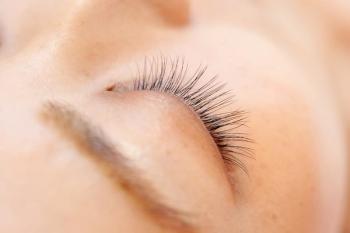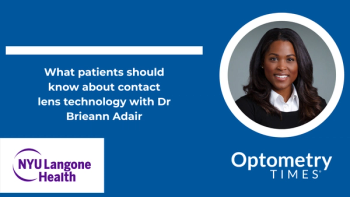
- April digital edition 2020
- Volume 12
- Issue 4
At-home therapy can alleviate contact lens discomfort
Warm compress supports healthy functioning of meibomian glands in contact lens wearers.
The therapeutic goal of adjunctive warm compress use is to heat the eyelids to help soften and partially melt any remaining material obstructing the glands. This is especially important in contact lens wearers, who may be experiencing dry eye, becauese it may reduce the contact lens dropout rate and improve patient quality of life while wearing lenses by increasing comfortable wear time.
Despite advances in contact lens designs and materials, discomfort remains the top reason for discontinuation of lens wear, with dropout rates estimated at 15.9 percent in the U.S. When considering that an estimated 40.9 million people in the U.S. aged 18 or older wear contact lenses, the magnitude of contact lens discomfort becomes quite clear.
Over the years, understanding of the physiological mechanisms that create this problem has expanded. This has enabled investigators to measure the effectiveness of treatment and improve care. With these goals in mind, a team of researchers at University of Alabama at Birmingham, School of Optometry, conducted a study on the effects of moist heat eye compress therapy, specifically on contact lens wearers. The report was recently published in Contact Lens and Anterior Eye and is summarized here.1
Related:
Study design
The purpose of the study was to investigate the effect of moist heat compress treatment on contact lens discomfort in subjects with contact lens-related dry eye (CLDE). During the four-week, single-center, open-label trial, 51 subjects were randomized to one of three treatment groups: application of a Bruder Compress twice per day (Group 1), application of a Bruder Compress once per day (Group 2), or warm washcloth application twice per day (Group 3). Subjects were previously diagnosed with CLDE using the Contact Lens Dry Eye Questionnaire long form (CLDEQ).
To help ensure compliance and daily data collection, subject diaries were kept. Clinical assessments included tear film break-up time, lipid layer thickness, and meibomian gland evaluation.
Related:
Reasons to try moist heat
No matter how healthy an eye is, contact lens wear disrupts the tear film because when the lens is placed on the eye, it splits the tear film in two: a pre- and post-lens tear film. In addition, a contact lens-disrupted tear film tends to exhibit an increased rate of evaporation. When this happens, contact lens surface wetting is compromised and the eye may not be adequately lubricated.
Beyond these expected challenges, patients who have meibomian gland dysfunction (MGD) face even greater problems because the lipid layer is already unstable. Indeed, MGD is a leading cause of dry eye and is known to contribute to contact lens discomfort. For this reason, treating MGD is essential in contact lens wearers.
There are many ways to treat MGD, but several target symptoms of malfunctioning glands rather than the root of their dysfunction. Although warm compress therapy may seem low-tech, it remains an effective treatment to improve secretion of meibum from the meibomian glands in patients with and without MGD, as was demonstrated in our study.
Related:
Proven benefits
Earlier research shows that the application of localized heat to the meibomian glands improves meibum secretion, which led to warm compresses having become an established and commonly prescribed treatment. In our study, the average increase in hours of comfortable wear time from baseline to Visit 3 (Week 4 of treatment) was 1.4±1.5 for Group 1, 2.2±3.2 for Group 2, and 1.8±2.5 for Group 3.
Interestingly, our study did not show a statistically significant difference in those who used the Bruder Moist Heat Compress twice a day (Group 1) versus once a day (Group 2). This is an important finding because it may make compliance with effective levels of therapy more attainable.
Related:
The inclusion of patient diaries in this study allowed us to calculate average compliance with therapy during the four-week study period. We found that average compliance for using the Bruder Moist Heat Compress once daily was 90.2 percent. Compliance dropped to 86 percent for use twice daily and to 79.6 percent for the washcloth group.
Also, patients who used warm washcloth therapy had more uncomfortable contact lens wear time on average when compared to subjects in Group 1 (p=0.02) at Visit 3. The average improvement in comfortable wear time in all subjects using the Bruder Moist Heat Compress was 1.8 hours.
Related:
Ocular surface signs and symptoms
In this study, symptom improvement was much more noticeable than improvement in signs, such as meibomian gland score, tear film break-up time and lipid layer thickness average and minimum. This may be due to the average baseline clinical parameters of subjects because none had severe ocular surface disease; instead, subjects were more reflective of patients ODs would select to initially treat with compresses and tears versus prescription-based therapies. However, subjects using the Bruder Moist Heat Compress showed a higher proportion of glands secreting meibum after treatment than subjects who had used a washcloth (p<0.01). When assessing symptoms, the average SPEED score improved from baseline (μ=11.7, SD=4.4) to Visit 3 (μ=7.6, SD=5.2) which was statistically and clinically significant (p<0.01). Similarly, average OSDI score improved from baseline (μ=28.0, SD=16.4) to Visit 3 (μ=16.7, SD=13.6) which was also statistically and clinically significant (p<0.01). No safety concerns were encountered.
Conclusion
It is imperative that ODs do all they can to support healthy functioning of the meibomian glands, especially in contact lens wearers. As this research demonstrates, warm compress therapy is an effective, viable first step in treatment prior to contact lens refitting. Warm compresses may also reduce the contact lens dropout rate and have a significant impact on a patient’s quality of life while wearing contact lenses by increasing comfortable wear time
Related:
References:
1. Tichenor AA, Cox SM, Ziemanski JF, et al. Effect of the Bruder moist heat eye compress on contact lens discomfort in contact lens wearers: An open-label randomized clinical trial. Cont Lens Anterior Eye. 2019 Dec;42(6):625-632.
Articles in this issue
over 5 years ago
Gene therapy: The future is nowover 5 years ago
Why patient occupation matters with dry eye diseaseover 5 years ago
Dry eye in the digital ageover 5 years ago
How to survive a lease terminationover 5 years ago
Comanaging intraocular lens power calculationsover 5 years ago
Life with COVID-19 makes a new normalover 5 years ago
10 new treatments in eye careover 5 years ago
How to manage the angle closure spectrumNewsletter
Want more insights like this? Subscribe to Optometry Times and get clinical pearls and practice tips delivered straight to your inbox.
















































.png)


